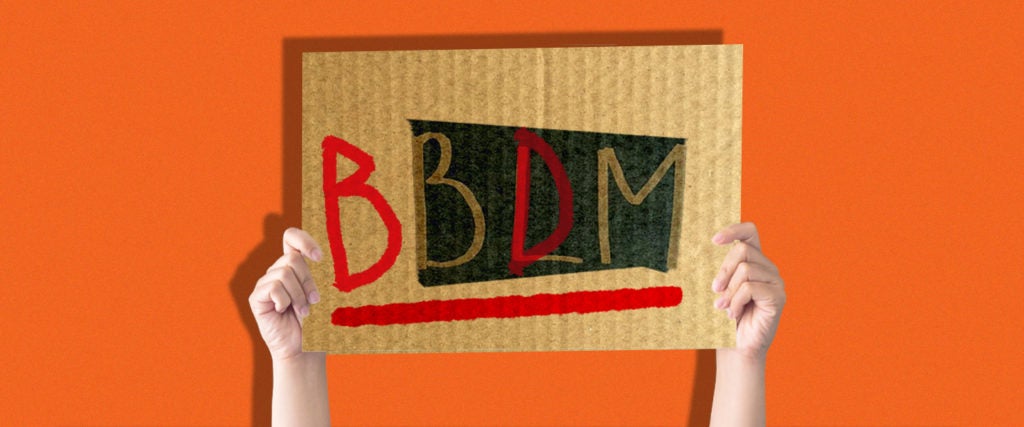As far as gay male poets go, I’m a bit reserved about sexual subjects in the writing I share. It isn’t modesty, I just love a bit of mystery and feel all of my business isn’t everybody’s to know. However, certain recent happenings have compelled me to deep-dive into the realm of amorous congress. There’s no choice but to address a bizarre habit at protests against police violence that concerns me and my sexual status directly: non-Black people using these serious sites to proclaim their love of Black dick.
I first noticed this on a sign in the crowd at a Black Lives Matter action last month in Brooklyn. I don’t remember the exact phrase written in bold lettering, but the handmade poster was a clear reference to “Don’t open your mouth for Black dick and keep it closed for Black issues” signs previously making the rounds online. Choosing that particular message as a white person says a lot about what your activism is focused on, but okay! I was glad to be far enough from it to not immediately scold some masked stranger in a cami and too-long jorts.
There are references to these phallic protest posters all over Twitter. I don’t want to link the actual images so as not to spread them further, but they’re easy to find. I can’t recall seeing anything like them at past actions for Black life, perhaps because the sort of people who’d do this are those who are new to the movement. Non-Black gay men have been doing it too, which shouldn’t surprise anyone with even a mild understanding of how gay men at large tend to value Black people. Anyone remember Black Cocks Matter, the brainchild of porn supervillain Michael Lucas?
Ain't really a fan of the "I love black dick" signs at these protest. We ain't tools.
— YG MALC JAX (@Malcjax) June 7, 2020
these white woman writing “i love black dick” on signs at protest is REALLY disturbing. like go to hell ew
— BREONNATAYLOR (@amaniijenae) June 7, 2020
Where it gets weird is when I hear “ugh I can’t wait to make mixed babies” or ive seen signs at protest “I love black dick, stop killing black men” or the idea of the taboo “jungle fever” some date black men cause there’s a lowkey rush for them
— GlizzyMcGuire (@GlizzyMcGuire__) June 25, 2020
In the poem “If His Name Were Mandingo,” the poet Essex Hemphill sums up our standing as Black, cis gay men in queer and non-queer contexts. “If he’s not hard-on / then he’s hard up / and either way / you watch him,” he writes. Our deemed usefulness to non-Black men starts and ends between our legs, a holdover from the lengthy history of our anatomies being treated as goods.
In gay visual art, this fixation has been thoroughly documented. The protesters lugging around “Big Black Cock”–centric signs follow in the footsteps of Touko Laaksonen, best known as Tom of Finland. Laaksonen is a staple of erotic art and gay counterculture… or something. It’s not hard to spot tattoos of his illustrations out and about at queer Brooklyn spots like the Rosemont or Riis Beach. Unfortunately, just as gay and straight Twitter users alike were quick to admire the Spanish army’s fascist La Legión regiment for their sexy uniforms, many have embraced Tom’s hypermasculine aesthetics without interrogating the racial politics of his work.
When Black men do appear in Laaksonen’s pieces, they’re nearly always an accessory to white desire. One seared in my memory depicts a white man being assaulted by four Black men. Another shows a Black man being belt-whipped by two white men.
As scholar Franklin Howard explains, “Tom sexualized potential police brutality and visually represented the social imbalance of power in his erotic art. Black men cannot even pleasure each other without the presence of white man.” A clear example that Howard cites is Tom’s Untitled (1988), a drawing where two cops bend a Black man over the hood of a police car while one prepares to penetrate him. There’s only so much point to assigning ethics to erotica, but at the same time, when compounded with the ongoing conversation on state-sanctioned violence… yikes.
But the commodification of Black fetishism among supposed “radicals” remains timeless. Both Laaksonen and these protesters with sex-centered signs place Blackness in a prop position while whiteness remains the star.
Still, Laaksonen is no Robert Mapplethorpe, the late, “edgy” homoerotic photographer. Mapplethorpe’s faceless, crotch-fixed photos of Black men in the 1980s are probably the best case study for art that speaks to today’s dick-crazed protest posters. His 1980 photograph “Man in Polyester Suit” is famously controversial for its exposure of the Black subject’s penis out of the fly of dress pants. The piece has become the blueprint for shenanigans of this flavor. Mapplethorpe went for it to the point that Milton Moore, the subject of “Man in Polyester Suit” and many other photographs, is believed to have once said he felt primitive beneath Mapplethorpe’s gaze: “I think he saw me like a monkey in a zoo.”
Sometimes I think that my penis — if magically granted autonomy to leap off my body and live its own life — might be valued more highly and by more people than my entire being. Black body parts are always profitable. But once our voices and brains get too involved, attempts to edit or silence us are never far off. That’s the simple truth for Black people enduring racial capitalism.
Black people in the U.S. toe a tightrope that’s inextricably knotted to chattel slavery and all conditions that rationalized it. “As a result of their structural position and the perspective it has given them, Black Americans are in a privileged position to critique racial capitalism,” American University professor Jordanna Matlon writes in Boston Review. “But that is a potentiality, not a foregone fact.” Engaging in depth with this violent legacy is somewhat optional, though. After all, that’s what our primary education has done with its biased history textbooks, dancing around this country’s extreme reliance on racial capitalism in achieving all it’s achieved. And by “dancing,” I mean a very extended “Cotton-Eye Joe” in a school gym, unbearably labored and disorienting.
Unfortunately, this might explain why certain Black people are too willing to play into racial fetishism, even bringing it up themselves to non-Black people as a sexual bargaining chip. Miseducation turns us against ourselves. Truth is, there can be no well-balanced bargaining of our Blackness while we remain haunted by inequity and the auction block. That’s the problem with how most American schools teach abolition — like it’s this thing that happened way back when that’s now all said and done. Unlike Little Fires Everywhere or Mrs. America, abolition isn’t a miniseries. It’s alive and afoot, and it’s the driving force behind the current movement for Black lives.
The prison-industrial complex is basically the wretched, predatory, greasy-haired grandson of slavery. He’s up to the same old tricks under different names and rules, an imperative point to remember in relation to what’s happening at these protests. Protest posters obsessed with one Black appendage exemplify how anti-Black ideologies segment Black people from our flesh. The news events of each day remind me enough of where I stand, so the last thing I need is that kind of messaging in a space that’s supposed to be mine.
This is also why referring to us as “Black bodies,” which seemingly seeks to reference our hypervisibility, really doesn’t do any good in the bigger picture. Our humanity remains unacknowledged by most power structures, whereas our physical bodies are for sure already acknowledged and put to use. Let it go, Elsa! Or Olaf, or whoever. (I’ve never seen Frozen.) Just abolish “Black bodies” from your protest vocab.
As scholar and abolitionist Ruth Wilson Gilmore explained on Rust Belt Abolition Radio in 2017, “Abolition is a plot against racial capitalism, which is all capitalism, not just some of it. It is a plot in a narrative sense. It is a plot in which the arc of change is always going resolutely toward freedom.” It’s about dismantling imperialism and cisheteropatriarchy, defunding and disbanding the police, axing prisons, building self-determined systems of community care and a host of other similar revolutionary processes. It’s about nerve, and it do take nerve. It’s not about “fixing” institutions that rely on the subjugation of Black and brown people, and it’s definitely not about your fetish for Black ding-a-ling.
Abolition runs counter to all forms of anti-Blackness, including that of late-capitalist ideology which makes people think it’s normal to base the value of someone’s life on their marketability. These dickmatized signs represent exactly that. Anyone who carries them or makes similar comments has a lot to learn about expressing solidarity without making Black people more uncomfortable.
Black fetishizing for “justice” is one of the louder heads of a sexually racist Hydra that plagues gay communities and beyond. In our reality of racial capitalism, a non-Black person using a protest sign to profess their love of Black dick at a rally for Black lives really isn’t so different than bringing a sign that revolves around their love of Pepsi. They see it as just another beloved product: unmistakably brown, pleasing, maybe prompting some guilt, certainly fostering strong brand loyalty and devoid of anything near full personhood. Just as Pepsi doesn’t work on cops in real life the way it did in Kendall Jenner’s ad, hitching your pro-Blackness onto sex stereotypes fails to help anyone other than you (and your sex organs, probably).
If you absolutely can’t help but bring that Michael Lucas–esque energy out on the town, just stay home and concentrate on donating directly to Black people and orgs instead, dweeb.

